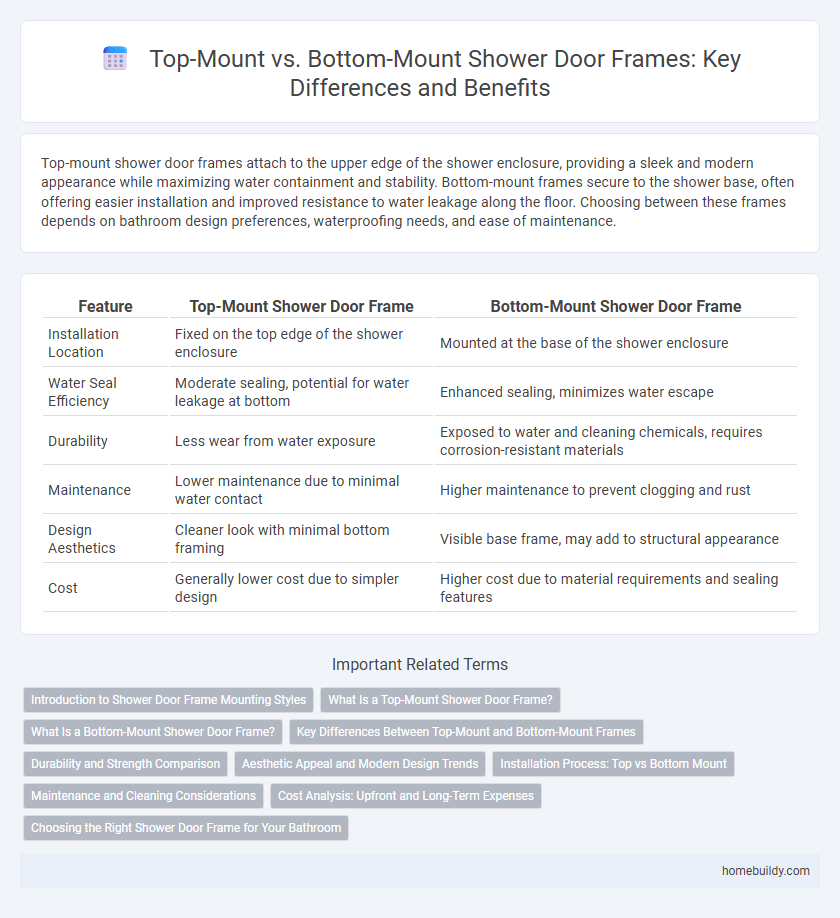Top-mount shower door frames attach to the upper edge of the shower enclosure, providing a sleek and modern appearance while maximizing water containment and stability. Bottom-mount frames secure to the shower base, often offering easier installation and improved resistance to water leakage along the floor. Choosing between these frames depends on bathroom design preferences, waterproofing needs, and ease of maintenance.
Table of Comparison
| Feature | Top-Mount Shower Door Frame | Bottom-Mount Shower Door Frame |
|---|---|---|
| Installation Location | Fixed on the top edge of the shower enclosure | Mounted at the base of the shower enclosure |
| Water Seal Efficiency | Moderate sealing, potential for water leakage at bottom | Enhanced sealing, minimizes water escape |
| Durability | Less wear from water exposure | Exposed to water and cleaning chemicals, requires corrosion-resistant materials |
| Maintenance | Lower maintenance due to minimal water contact | Higher maintenance to prevent clogging and rust |
| Design Aesthetics | Cleaner look with minimal bottom framing | Visible base frame, may add to structural appearance |
| Cost | Generally lower cost due to simpler design | Higher cost due to material requirements and sealing features |
Introduction to Shower Door Frame Mounting Styles
Top-mount shower door frames attach at the top of the enclosure, providing a sleek and modern look while enhancing water containment. Bottom-mount frames are secured at the base, offering increased stability and easier installation on uneven surfaces. Choosing between these mounting styles depends on bathroom layout, desired aesthetics, and waterproofing needs.
What Is a Top-Mount Shower Door Frame?
A top-mount shower door frame is a structural design where the door's support and track are installed at the top edge of the shower enclosure, providing enhanced stability and smooth sliding operation. This configuration minimizes water leakage by creating a secure upper seal and reduces wear on the bottom threshold, promoting longevity. Top-mount frames are especially beneficial for frameless or semi-frameless glass doors, offering a sleek, modern appearance while maintaining durability.
What Is a Bottom-Mount Shower Door Frame?
A bottom-mount shower door frame is designed with the frame installed along the base or threshold of the shower, providing a sturdy seal against water leakage. This type of frame is often favored for its easy installation and clean, streamlined appearance, making it ideal for showers without a built-in curb. Bottom-mount frames enhance water containment by creating a secure barrier at the lowest point of the shower enclosure.
Key Differences Between Top-Mount and Bottom-Mount Frames
Top-mount shower door frames attach securely to the top of the enclosure, offering enhanced stability and preventing water leakage more effectively than bottom-mount frames. Bottom-mount shower door frames are installed at the base, providing a sleek, minimalist appearance but may require more frequent maintenance to avoid water seepage. Key differences lie in installation location, water resistance, maintenance needs, and the overall aesthetic impact on the bathroom design.
Durability and Strength Comparison
Top-mount shower door frames offer superior durability due to their support at the top, reducing stress on hinges and minimizing sagging over time. Bottom-mount shower door frames rely heavily on the threshold for stability, making them more prone to water damage and wear. Materials used in top-mount frames, such as aluminum or stainless steel, often enhance strength, ensuring a longer lifespan compared to bottom-mount counterparts.
Aesthetic Appeal and Modern Design Trends
Top-mount shower door frames offer a sleek, minimalist look favored in modern bathroom designs, enhancing aesthetic appeal with their clean lines and seamless integration. Bottom-mount frames tend to emphasize durability and water containment but may appear bulkier, making them less ideal for contemporary minimalist trends. Contemporary design trends prioritize frameless or top-mount styles for their ability to create an open, airy feel and showcase high-end tile or glass features.
Installation Process: Top vs Bottom Mount
Top-mount shower door frames are installed by securing the frame to the ceiling or upper wall area, offering easier alignment and reducing the need for floor modifications. Bottom-mount shower door frames require precise attachment to the shower base or floor, often demanding sealant application to prevent water leakage and more detailed floor preparation. Installation time varies, with top-mount frames generally quicker to fit due to their elevated anchoring compared to the more labor-intensive bottom-mount process.
Maintenance and Cleaning Considerations
Top-mount shower door frames offer easier access for cleaning since the frame is mounted at the top, reducing water and soap scum accumulation around the base. Bottom-mount shower door frames require more frequent maintenance to prevent mold and mildew buildup in the track where water tends to collect. Regular wiping and use of mildew-resistant sealants are essential for bottom-mount frames to ensure longevity and maintain a clean appearance.
Cost Analysis: Upfront and Long-Term Expenses
Top-mount shower door frames generally have higher upfront costs due to premium materials and installation complexity but offer reduced long-term maintenance expenses by minimizing water leakage and wear. Bottom-mount frames feature lower initial prices and simpler installation but may lead to increased repair and replacement costs over time due to water damage and seal degradation. Analyzing total cost of ownership reveals that top-mount frames provide better long-term value despite the initial investment.
Choosing the Right Shower Door Frame for Your Bathroom
Top-mount shower door frames offer a sleek, modern look with easier cleaning and reduced risk of water leakage, making them ideal for bathrooms with minimal floor drainage. Bottom-mount shower door frames provide enhanced stability and durability, supporting heavier glass panels and fitting well in bathrooms with uneven floors. Selecting the right frame depends on bathroom layout, water control needs, and design preferences to ensure functionality and aesthetics.
Top-mount shower door frame vs bottom-mount shower door frame Infographic

 homebuildy.com
homebuildy.com